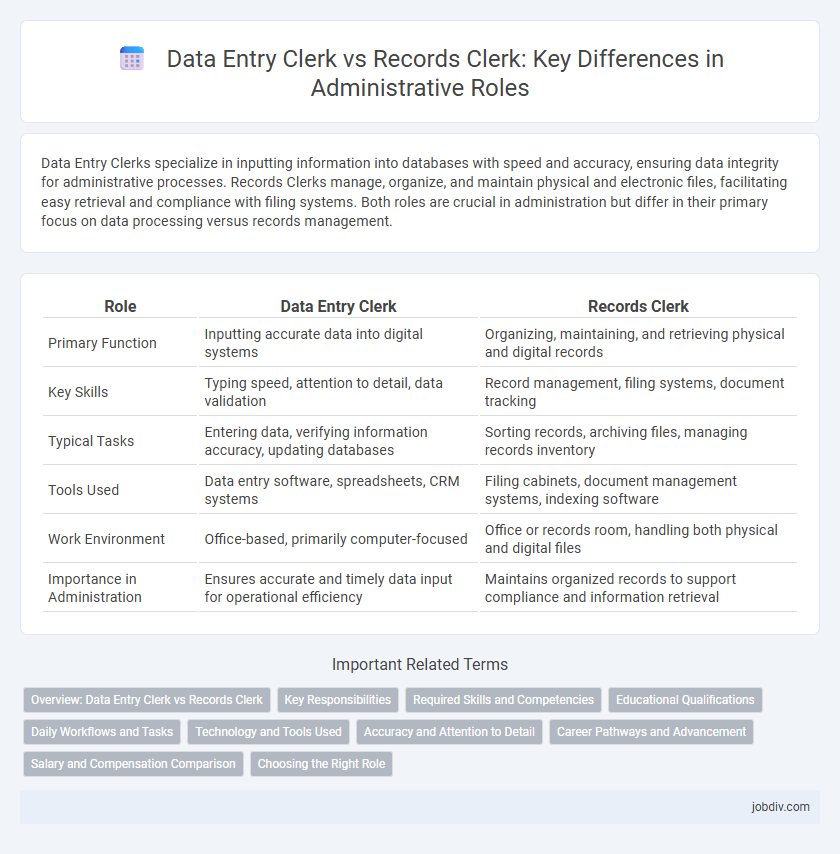Data Entry Clerks specialize in inputting information into databases with speed and accuracy, ensuring data integrity for administrative processes. Records Clerks manage, organize, and maintain physical and electronic files, facilitating easy retrieval and compliance with filing systems. Both roles are crucial in administration but differ in their primary focus on data processing versus records management.
Table of Comparison
| Role | Data Entry Clerk | Records Clerk |
|---|---|---|
| Primary Function | Inputting accurate data into digital systems | Organizing, maintaining, and retrieving physical and digital records |
| Key Skills | Typing speed, attention to detail, data validation | Record management, filing systems, document tracking |
| Typical Tasks | Entering data, verifying information accuracy, updating databases | Sorting records, archiving files, managing records inventory |
| Tools Used | Data entry software, spreadsheets, CRM systems | Filing cabinets, document management systems, indexing software |
| Work Environment | Office-based, primarily computer-focused | Office or records room, handling both physical and digital files |
| Importance in Administration | Ensures accurate and timely data input for operational efficiency | Maintains organized records to support compliance and information retrieval |
Overview: Data Entry Clerk vs Records Clerk
A Data Entry Clerk specializes in accurately inputting, updating, and managing digital information using software applications, ensuring data integrity and timely processing. A Records Clerk focuses on organizing, maintaining, and retrieving physical or electronic records, emphasizing proper classification and compliance with retention policies. Both roles contribute to effective information management but differ in scope, with Data Entry Clerks handling data input processes and Records Clerks managing information storage and access.
Key Responsibilities
Data Entry Clerks primarily focus on inputting, updating, and maintaining accuracy of data in computer systems or databases, ensuring information is correctly recorded and accessible. Records Clerks manage the organization, storage, retrieval, and maintenance of physical and electronic records, emphasizing proper classification and compliance with retention policies. Both roles require attention to detail, but Data Entry Clerks emphasize data accuracy and speed, while Records Clerks concentrate on systematic record keeping and regulatory adherence.
Required Skills and Competencies
Data Entry Clerks require strong typing skills, attention to detail, and proficiency in data management software to accurately input and update information. Records Clerks must possess organizational abilities, knowledge of filing systems, and familiarity with document control procedures to efficiently manage and retrieve physical or digital records. Both roles demand accuracy, time management, and basic computer literacy to support effective information administration.
Educational Qualifications
Data Entry Clerks typically require a high school diploma or equivalent, with additional training in computer applications, typing skills, and data management software enhancing job performance. Records Clerks often need similar educational backgrounds but may require specialized knowledge in records management, filing systems, and potentially certifications such as Certified Records Manager (CRM) for advanced roles. Employers prioritize candidates who demonstrate proficiency in accurate data handling, organizational skills, and familiarity with regulatory compliance related to data privacy.
Daily Workflows and Tasks
Data Entry Clerks focus on inputting, updating, and verifying digital data using software systems, ensuring accuracy and timely processing of information. Records Clerks manage the organization, storage, retrieval, and disposal of physical or electronic records, maintaining compliance with regulatory standards and data retention policies. Daily workflows for Data Entry Clerks involve high-volume keyboarding and data validation, while Records Clerks prioritize filing, indexing, and safeguarding document integrity.
Technology and Tools Used
Data Entry Clerks primarily use keyboarding software, spreadsheet applications like Microsoft Excel, and database management systems to input and update digital information efficiently. Records Clerks rely on electronic document management systems (EDMS), barcode scanners, and cloud-based archival platforms to organize, retrieve, and maintain physical and digital records securely. Both roles increasingly incorporate automation tools such as optical character recognition (OCR) and data validation software to enhance accuracy and streamline workflow in administrative environments.
Accuracy and Attention to Detail
Data Entry Clerks prioritize accuracy by inputting large volumes of information into databases with meticulous attention to detail to prevent errors that could disrupt workflows. Records Clerks focus on maintaining precise and organized filing systems, ensuring all documents are accurately classified and easily retrievable. Both roles demand high levels of attention to detail, but Data Entry Clerks emphasize error-free data input while Records Clerks concentrate on the systematic accuracy of document management.
Career Pathways and Advancement
Data Entry Clerks often advance by developing specialized technical skills, such as proficiency in database management and data analysis software, leading to roles like Data Analysts or Administrative Coordinators. Records Clerks typically progress by gaining expertise in record-keeping systems, compliance standards, and information governance, opening pathways to positions such as Records Managers or Compliance Specialists. Both career pathways benefit from certification programs and continuous education in information management, enhancing opportunities for higher-level administrative or management roles.
Salary and Compensation Comparison
Data Entry Clerks typically earn an average salary ranging from $28,000 to $40,000 annually, reflecting their role in accurately inputting and managing digital data. Records Clerks often receive similar compensation, with average salaries between $30,000 and $42,000 per year, as they specialize in organizing and maintaining physical and electronic records. Variations in salary depend on factors such as industry, geographic location, and years of experience, with Records Clerks sometimes commanding higher pay due to handling sensitive or critical information management tasks.
Choosing the Right Role
Selecting the right role between a Data Entry Clerk and a Records Clerk requires analyzing job responsibilities and skill sets. Data Entry Clerks specialize in accurately inputting information into databases, emphasizing speed and attention to detail, while Records Clerks manage organizing, storing, and retrieving physical or electronic records, demanding strong organizational skills. Understanding the specific needs of the organization ensures the alignment of expertise with role expectations for optimal administrative efficiency.
Data Entry Clerk vs Records Clerk Infographic

 jobdiv.com
jobdiv.com